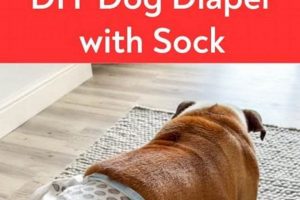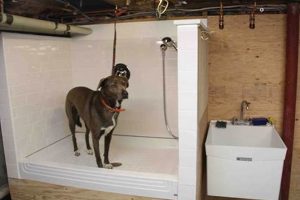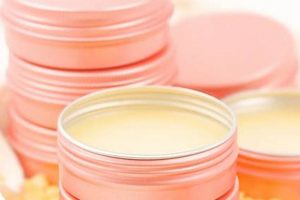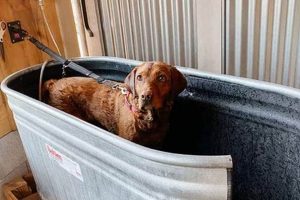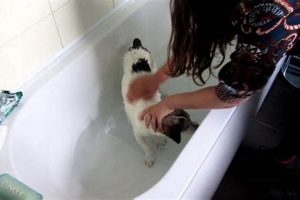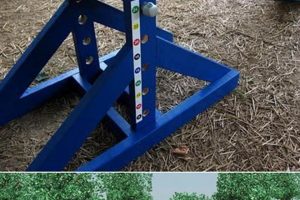A custom furniture piece that combines an animal enclosure with a functional table surface represents a dual-purpose design. These items typically integrate a standard dog crate within a wooden or metal framework, allowing the structure to serve as both a secure resting space for a pet and a useful platform for household objects. The crafting of these units commonly involves modification of existing crates or construction from scratch using woodworking or metalworking techniques, allowing for personalized dimensions and aesthetic features.
The creation of such a piece offers several advantages, including space optimization in smaller living areas and the potential for cost savings compared to purchasing separate pieces of furniture. Furthermore, this approach allows owners to integrate their pet’s living space seamlessly into the existing home decor, resulting in a unified and visually appealing interior. Historically, the concept of integrated pet furniture has evolved from simple animal houses to more sophisticated and aesthetically pleasing designs reflecting changing trends in interior design and pet ownership.
The following sections will address aspects of planning, construction techniques, design considerations, and safety measures applicable to the construction of this integrated furniture. Detailing the selection of appropriate materials, the application of relevant joinery methods, and the implementation of secure locking mechanisms will provide a comprehensive understanding of the building process.
Construction Guidelines
These guidelines provide critical information for constructing a safe and functional piece of integrated pet furniture. Prioritization of structural integrity and pet safety is paramount throughout the construction process.
Tip 1: Material Selection: Choose materials appropriate for both load-bearing capacity and resistance to pet-related wear. Hardwoods such as oak or maple are recommended for frame construction, while non-toxic finishes are essential for surfaces accessible to the animal.
Tip 2: Accurate Measurements: Precise measurement of the existing crate dimensions is crucial. Add sufficient clearance (at least 2 inches) around the crate to facilitate ventilation and ease of removal for cleaning.
Tip 3: Secure Joinery: Employ robust joinery techniques such as mortise and tenon or pocket-hole screws with wood glue to ensure the frame’s structural stability. Avoid using nails or staples alone for load-bearing connections.
Tip 4: Ventilation Considerations: Maintain adequate airflow within the enclosed space. Incorporate ventilation openings or gaps in the tabletop to prevent the accumulation of heat or odors.
Tip 5: Safety Hardware: Utilize child-safe latches or locking mechanisms to secure the crate within the table frame. This prevents accidental opening by the animal or small children.
Tip 6: Smooth Surfaces: Sand all surfaces thoroughly to eliminate splinters or sharp edges that could cause injury to the animal or its handlers. Apply multiple coats of a durable, pet-safe sealant.
Tip 7: Weight Distribution: Design the structure to distribute weight evenly across the floor. Consider adding adjustable leveling feet to compensate for uneven surfaces.
These construction guidelines ensure both the functionality and safety. Adherence to these principles will result in a durable and aesthetically pleasing furniture piece that provides a secure and comfortable environment for the pet.
The subsequent sections will examine design options and aesthetic considerations.
1. Structural Integrity
Structural integrity, in the context of constructing a combined pet enclosure and table, denotes the ability of the structure to withstand anticipated loads and stresses without deformation or failure. The inherent nature of such a design necessitates consideration for both static loads, such as the weight of objects placed on the tabletop, and dynamic loads, including the movement and weight of the animal housed within. Failure to adequately address structural integrity can result in compromised safety for the pet, instability of the furniture piece, and premature degradation of the materials used. A real-life example might involve a table collapsing due to inadequate support beams, potentially injuring the animal or damaging surrounding property. Proper structural design is therefore an indispensable element.
The practical application of structural integrity principles involves several key considerations. Selection of appropriate materials is paramount; hardwoods, such as oak or maple, generally provide greater load-bearing capacity than softwoods. Equally important is the implementation of robust joinery techniques, such as mortise-and-tenon or dowel joints, which distribute stress more effectively than simple screw connections. Further, the inclusion of internal support structures, such as reinforcing ribs or strategically placed vertical supports, can significantly enhance the overall strength of the table. Finite element analysis software, although typically beyond the scope of the average enthusiast, can be used to model stress distribution and identify potential weak points in the design.
In summary, structural integrity represents a foundational aspect of the construction of an integrated pet enclosure and table. The challenges associated with achieving adequate structural integrity often involve balancing aesthetic considerations with the imperative of ensuring safety and durability. A thorough understanding of load-bearing principles, material properties, and joinery techniques is essential. Neglecting these factors undermines the functionality of the project and potentially introduces risks to the animal and its environment.
2. Ventilation Adequacy
Ventilation adequacy is a critical design parameter for any enclosure intended to house a living animal, and its significance is amplified in the context of a dual-purpose furniture piece. Insufficient airflow within a combined animal crate and table directly affects the animal’s well-being, leading to a potential build-up of humidity, unpleasant odors, and elevated temperatures. These conditions can contribute to respiratory distress, skin irritations, and increased susceptibility to infections. The causal relationship between inadequate ventilation and compromised animal health necessitates careful consideration of design elements that promote effective air exchange. A real-world example illustrates this: a crate constructed with solid walls and a tightly sealed tabletop could create a stagnant air environment, especially in warmer climates, leading to heat stress in the animal.
The practical application of ventilation principles in integrated pet furniture design involves several strategies. The incorporation of strategically placed openings or vents along the sides, back, or top of the structure facilitates cross-ventilation. The size and number of these openings must be calculated to ensure adequate airflow without compromising structural integrity or security. Furthermore, the choice of materials influences ventilation; for instance, mesh panels or perforated materials promote better air circulation than solid wood or metal sheets. Orientation of the structure within the room should also be considered, avoiding placement in areas with restricted airflow, such as against walls or near heat sources. The effectiveness of the ventilation system can be empirically verified using temperature and humidity monitoring devices inside the enclosure.
In summary, ventilation adequacy is not merely a superficial consideration but a fundamental requirement for the responsible design and construction of combined pet enclosures and tables. The potential adverse consequences of inadequate airflow on the animal’s health necessitate a proactive and informed approach. Addressing these issues by implementing appropriate design strategies ensures the creation of a safe, comfortable, and hygienic living space for the animal, while maintaining the functionality of the furniture piece. The challenge lies in balancing aesthetic preferences with the ethical obligation to prioritize the animal’s well-being, ensuring that the design serves both human and animal needs effectively.
3. Material Compatibility
The selection of compatible materials is paramount in the creation of a durable and safe animal enclosure integrated into a functional table. The inherent interaction between the materials, the pet housed within, and the intended use of the table necessitates careful consideration to avoid potential hazards and ensure structural longevity.
- Wood and Finishes
The primary structural material, wood, must be paired with appropriate finishes. Untreated wood is susceptible to moisture damage from pet waste and can harbor bacteria. Furthermore, many commercially available wood finishes contain volatile organic compounds (VOCs) that can be harmful to animals. The selection of non-toxic, water-based sealants and paints is crucial to prevent ingestion and respiratory irritation. An example is the use of formaldehyde-free plywood, contrasted with conventional plywood which emits harmful gases.
- Metal and Coatings
Metal components, such as crate bars or reinforcing elements, require careful consideration of coatings. Galvanized steel, while durable, can leach zinc if scratched or damaged, posing a toxicity risk to animals. Powder coating provides a more inert and durable barrier against corrosion and potential ingestion. Stainless steel offers a naturally corrosion-resistant alternative but is typically more expensive. The choice should balance cost with the assurance of non-toxicity and resistance to wear and tear.
- Fabric and Fasteners
The use of fabrics for bedding or cushioning introduces further compatibility considerations. Natural fibers such as cotton or hemp are preferable to synthetic materials, which can off-gas harmful chemicals and may be more easily ingested if chewed. Fasteners used to secure fabric elements must be robust and non-toxic. Avoiding small, detachable parts reduces the risk of choking hazards. Flame-retardant treatments on fabrics should be carefully scrutinized to ensure they do not contain harmful substances.
- Adhesives and Joinery
Adhesives used in the construction process must be chosen with regard to both structural integrity and animal safety. Traditional wood glues, such as polyvinyl acetate (PVA) adhesives, are generally considered safe once fully cured, but the selection of low-VOC or non-toxic alternatives minimizes potential exposure during construction. Joinery methods, such as mortise and tenon or dowel joints, reduce the reliance on adhesives, thereby minimizing the risk of chemical exposure. The integrity of the joint itself is critical to prevent separation and potential injury to the animal.
Consideration of these facets of material compatibility is central to the responsible construction of combined pet enclosures and tables. The diligent selection of materials, guided by principles of non-toxicity, durability, and resistance to animal-related wear, ensures the creation of a safe and functional piece of furniture that promotes the well-being of the pet and enhances the longevity of the structure itself.
4. Accessibility Facilitation
Accessibility facilitation, in the context of a self-constructed animal enclosure integrated into a table, refers to the design considerations that promote ease of access for both the animal and the human caretaker. This concept extends beyond mere physical entry and encompasses aspects of cleaning, maintenance, and the ability to interact with the animal without undue difficulty. The efficacy of accessibility design directly influences the practicality and usability of the combined furniture piece.
- Crate Removal Systems
A primary facet of accessibility is the design of a system that allows for the easy removal and replacement of the internal crate component. This is critical for thorough cleaning, replacement of bedding, and potential repair or modification of the crate itself. An example would be a sliding drawer mechanism or a hinged tabletop section that provides unobstructed access. The absence of such a system would necessitate disassembly of the entire table structure, significantly increasing the time and effort required for routine maintenance.
- Entry and Exit Points
The design and placement of entry and exit points for the animal also affect accessibility. A low threshold facilitates entry for older or mobility-impaired animals. The dimensions of the opening must be adequate for the animal’s size while maintaining security. Moreover, the location of the entry point should be convenient for both the animal and the caretaker, minimizing disruption to the surrounding environment. A poorly placed entry point could lead to obstruction of walkways or interference with other furniture.
- Cleaning Access
Facilitating easy cleaning is an indispensable aspect of accessibility. Design considerations should include smooth, non-porous surfaces that are easily wiped down. The incorporation of removable trays or liners simplifies the removal of waste and debris. Additionally, access to all interior surfaces should be unimpeded, allowing for thorough disinfection and odor control. Lack of such considerations could result in unsanitary conditions and potential health risks for the animal.
- Interaction and Observation
Accessibility extends to the ability of the caretaker to interact with and observe the animal within the enclosure. This can be achieved through the inclusion of viewing windows or open mesh sections that allow for visual contact and communication. Furthermore, a design that allows for easy placement of food and water bowls without requiring the animal to exit the crate enhances convenience and reduces stress. Restrictions to interaction and observation could impede the bonding process and limit the ability to monitor the animal’s health and well-being.
These facets of accessibility facilitation are central to the successful integration of an animal enclosure into a functional furniture piece. Prioritizing these elements during the design and construction phases ensures a practical, usable, and humane living space for the animal while simplifying the tasks associated with pet care and maintenance. By addressing these considerations, the “diy dog crate table” becomes a truly functional and beneficial addition to the household.
5. Aesthetic Integration
Aesthetic integration, within the context of designing and constructing a combined pet enclosure and table, refers to the harmonization of the functional furniture piece with the existing interior design and decor of a given space. Its importance stems from the desire to create a cohesive and visually pleasing environment, wherein the practical purpose of housing a pet does not detract from, and ideally enhances, the aesthetic qualities of the room. A poorly integrated structure, even if functionally sound, can create a visual dissonance that detracts from the overall ambiance of the home. This stands in contrast to a well-integrated piece, which appears as a deliberate design element, seamlessly blending with the surrounding furniture and architectural features. For example, a rustic-style table constructed from reclaimed wood might complement a farmhouse-style interior, while a sleek, minimalist design would be more appropriate for a contemporary living space.
The practical application of aesthetic integration involves several key considerations. Material selection plays a pivotal role; the type of wood, metal, fabric, and finishes should align with the existing palette and textures of the room. Color choices are equally important, as the paint or stain of the table should complement or subtly contrast with the surrounding walls, flooring, and furniture. Furthermore, the overall style and design of the table should reflect the architectural features of the room; a modern, geometric design might clash with a traditional, ornate interior. The scale of the table is also critical; a large, bulky structure can overwhelm a small space, while a diminutive table may appear insignificant in a larger room. Details such as hardware, trim, and decorative elements should be carefully chosen to reinforce the desired aesthetic theme.
In conclusion, aesthetic integration is a crucial element in the successful design and construction of integrated pet enclosures and tables. The challenges associated with achieving effective integration often involve balancing personal preferences with the constraints of the existing interior design. A thoughtful and informed approach, guided by principles of design harmony and visual coherence, ensures the creation of a functional and aesthetically pleasing piece of furniture that enhances the overall ambiance of the home. Overlooking this element can result in a jarring and discordant addition to the living space, underscoring the significance of aesthetic integration as a key component in the planning and execution of this type of project.
Frequently Asked Questions
The following addresses common inquiries pertaining to the construction and implementation of custom-built pet enclosures integrated into furniture.
Question 1: What structural materials are best suited for the construction of a “diy dog crate table” to ensure the safety of the enclosed animal?
Hardwoods such as oak, maple, or birch are generally preferred due to their inherent strength and resistance to damage. Softwoods may be used for non-load-bearing elements. Metal frames constructed of steel or aluminum provide an alternative for enhanced durability. Proper joinery and load distribution are critical, regardless of material selection.
Question 2: How can adequate ventilation be ensured within a “diy dog crate table” to prevent the buildup of harmful gases or overheating?
Incorporation of strategically placed ventilation openings, such as mesh panels or slotted vents, is essential. The dimensions and placement of these openings should be calculated to ensure sufficient airflow based on the animal’s size and the ambient temperature of the environment. Avoidance of airtight seals is also recommended.
Question 3: What finishes and coatings are safe for use on a “diy dog crate table” to minimize the risk of ingestion or respiratory irritation for the animal?
Only non-toxic, water-based paints, sealants, and varnishes should be used. Avoid products containing volatile organic compounds (VOCs), formaldehyde, or heavy metals. Allow finishes to fully cure before introducing the animal to the enclosure. Consult product safety data sheets to verify suitability.
Question 4: What design considerations should be prioritized to facilitate easy cleaning and maintenance of a “diy dog crate table”?
Removable trays or liners, smooth and non-porous surfaces, and easy access to all interior areas are essential. Designs should allow for convenient removal of bedding and waste. The use of durable, water-resistant materials simplifies cleaning and prevents the absorption of odors.
Question 5: How can a “diy dog crate table” be designed to minimize the risk of injury to the animal, such as sharp edges or entrapment hazards?
Thorough sanding of all surfaces to eliminate splinters or sharp edges is imperative. Avoid the use of small, detachable parts that could be ingested. Design openings and spaces to prevent the animal from becoming trapped. Regularly inspect the structure for any signs of damage or wear.
Question 6: What methods can be employed to secure the animal within a “diy dog crate table” while still allowing for easy access and release by the owner?
Child-safe latches, robust locking mechanisms, and secure hinges are recommended. The design should prevent the animal from easily opening the enclosure from the inside. Ensure that the locking mechanism is easily accessible and operable by the owner in case of emergency.
Adherence to these guidelines is crucial for ensuring that the construction is both functional and safe for the animal. Careful planning and execution are vital for a beneficial outcome.
The subsequent section will address advanced customization options.
Conclusion
The preceding sections have detailed key aspects of constructing an animal enclosure integrated into a functional table, emphasizing structural integrity, ventilation adequacy, material compatibility, accessibility facilitation, and aesthetic integration. These factors are not merely design considerations but essential elements influencing the safety, comfort, and long-term viability of the final product. The diligent application of these principles is paramount for responsible construction.
The decision to undertake a “diy dog crate table” project necessitates a commitment to thorough planning, precise execution, and a dedication to the well-being of the animal. It is incumbent upon the builder to prioritize safety and functionality above aesthetic preferences, ensuring that the resulting structure serves its intended purpose effectively and ethically. Future endeavors should focus on innovative design approaches and exploration of sustainable materials to further enhance the benefits and minimize the environmental impact.


